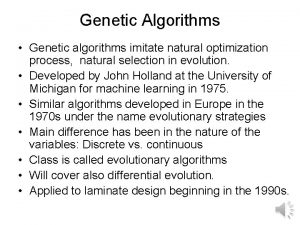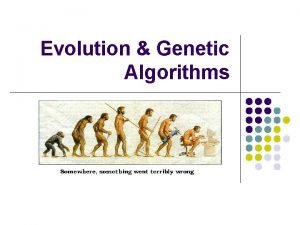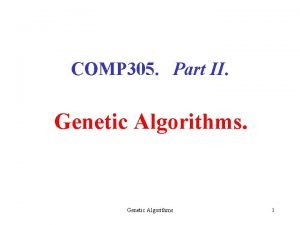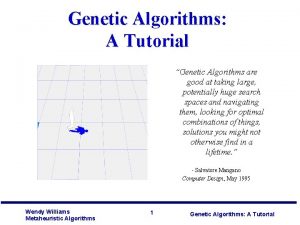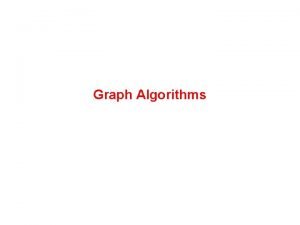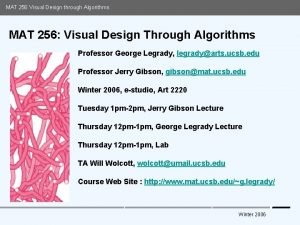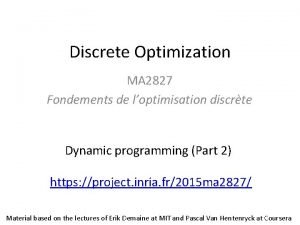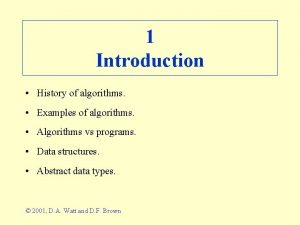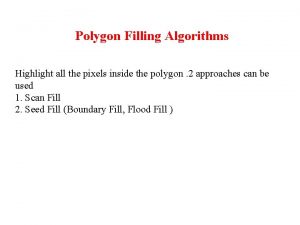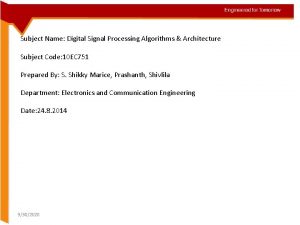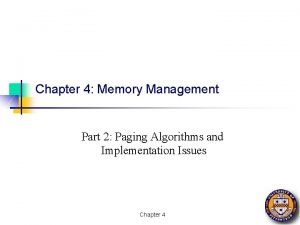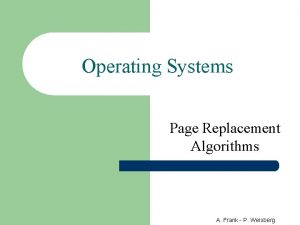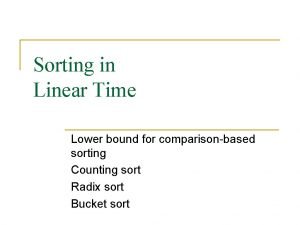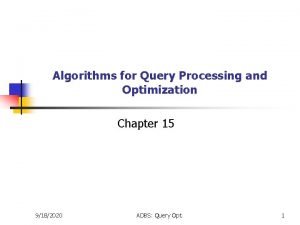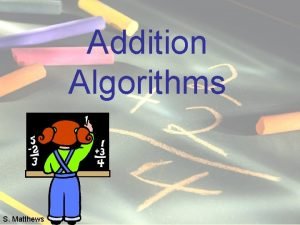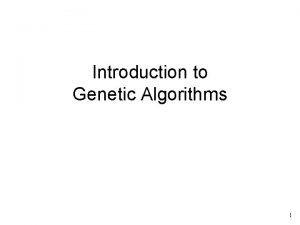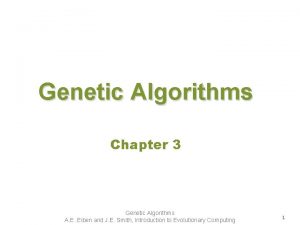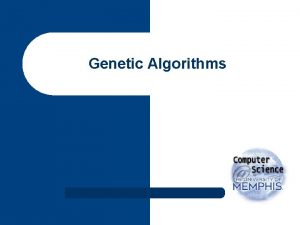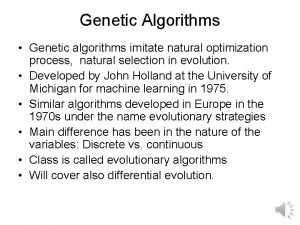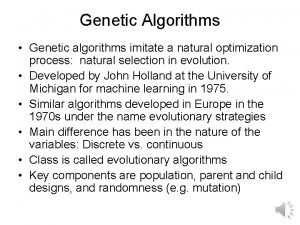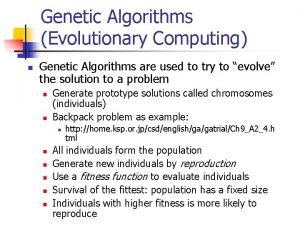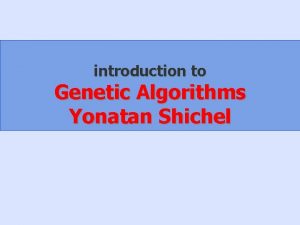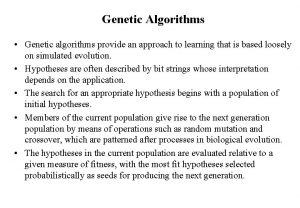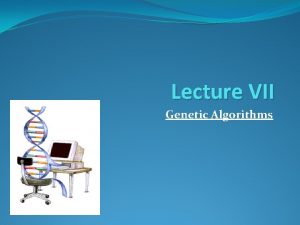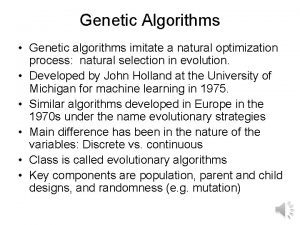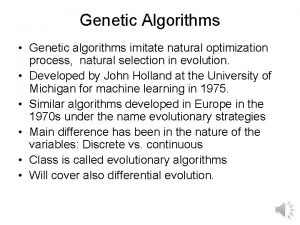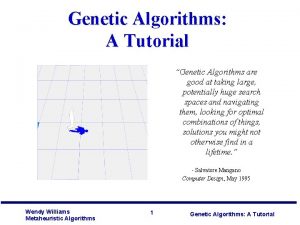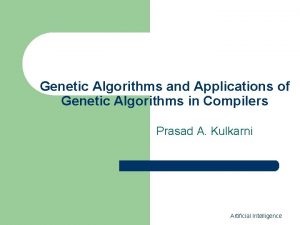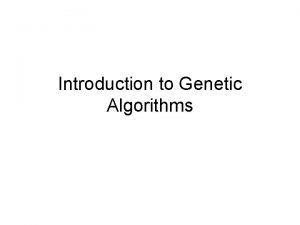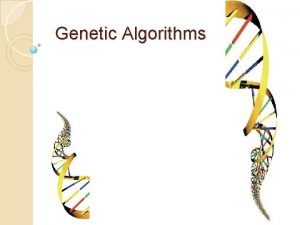Genetic Algorithms l l l Genetic Algorithms What




















- Slides: 20

Genetic Algorithms l l l Genetic Algorithms – What are they? And how they are inspired from evolution. Operators and Definitions in Genetic Algorithms paradigm. -chromosomes -crossover, mutation and selection -population, fitness and elitism Applications of Genetic Algorithms. Real Parameter Genetic Algorithms. Parent Centric Recombination Operator & G 3 model.

Genetic algorithms are search algorithms based on the mechanics of natural selection and natural genetics (Goldberg 1989). l GA s exploit the idea of the survival of the fittest and an interbreeding population to create a novel and innovative search strategy. l In nature weaker members of a species tend to die away, leaving the stronger and fitter to mate, create offspring which evolve themselves into newer species and ensure the continuing survival of the fittest. l GA s are a form of randomized search, in that the way in which solutions are chosen and combined is a stochastic process rather than traditional deterministic problem solving techniques. l

Operators and Definitions Chromosome -- A possible solution to a problem represented traditionally as a binary string ( e. g. 11000110) l Crossover-- When two individuals mate, both parents pass their chromosomes onto their offspring. The two chromosomes come together and swap genetic material. In binary GA s crossover is performed by swapping a part of binary strings between two solutions at a randomly chosen cross-site with some probability. It is a binary operator. l

Operators and Definitions Mutation – Conversion of proteins from one to another. In Binary GA s mutation is performed by converting some random bit of a binary string into its complementary bit (ie a 1 to a 0 or vice versa) with some probability. It is a unary operator. l Mutation will help prevent the population from stagnating. It adds “fresh blood” to a population of solutions to a problem. It adds diversity. l

Operators and Definitions Fitness – The measure of goodness of a solution. (e. g. the function value of a solution in an optimization problem). l Selection – The Darwinian selection mechanism to eliminate bad solutions in a population. l Population – A pool of solutions represented as binary strings (chromosomes) that undergo -- selection (based on their fitness) -- crossover (mutually among themselves randomly) -- mutation (randomly) Note – crossover and mutation destroy old solutions l Elitism – Some elite (good) solutions are carried onto the next generation without being destroyed. It is considered to be a good strategy. l

Roulette Wheel Selection Solutions are selected on the basis of the percentage that their fitness contributes to the cumulative fitness of the whole population

GA flowchart

GA dynamics

Applications of GA s are especially useful when -- The search space is large, complex or poorly understood. -- Domain knowledge is scarce or expert knowledge is difficult to encode to narrow the search space. -- No mathematical analysis is available. -- Traditional search methods fail. Typically over the years GA s have been successfully applied to l Function and Structural Optimization l Database Query Optimization l Determination of Protein Structures l Scheduling Problems l Construction and Training of Neural Networks l Engineering Design l Multi-criteria Decision Making (one of the hottest fields for GA s) l Music Composition l

Real Parameter Genetic Algorithms A number of real world applications involve object variables which are real valued l In the past few years researchers have tried to simulate the principles of crossover, mutation and selection in real-valued space directly. l A number of Real parameter crossover and mutation operators have been proposed: -- Simulated Binary Crossover (SBX) (Deb 1995) -- Evolution Strategies (ES) (Rechenberg & Schwefel) -- Unimodal Normal Distribution Crossover (UNDX) (Kita 1997) -- Simplex Crossover (SPX) (Yamamura 1997) -- Parent Centric Crossover (PCX) (Deb 2001) l

Real Coded Crossovers l UNDX -- It is a generic multi-parent crossover operator which emphasizes offspring closer to the geometric centroid of the parents. UNDX SPX l SPX – It is a generic multi-parent crossover operator which uses a uniform probability to generate offspring inside a simplex determined by the parents. l PCX – It is a generic multi-parent crossover PCX operator which emphasizes offspring closer to the parents.

Some Test Functions for Real GA s l Schwefel’s Function l Ellipsoidal Function l Gen. Rosenbrock’s Function

Generalized Generation Gap Model (G 3 model) The breeding scheme of Binary GA s is modified as follows l From Population P, select the best parent and (M-1) other parents randomly. l Generate N offspring from the chosen M parents using some recombination scheme. (UNDX, PCX etc). l Choose two parents (p 1 and p 2) at random from the population P. l From the combined sub-population of p 1, p 2 and N created offspring, choose the best two solutions and replace p 1 and p 2 with these two solutions. l Another modification is to replace only one parent in the population with best offspring. (Modified G 3 model)

Results Graphically presented are the number of function evaluations required to find a solution of fitness of 1 e-20 for Felp as a function of the pool size (N here lambda). l A parametric study to find the optimal population size. l

Results Graphically presented are the number of function evaluations required to find a solution of fitness of 1 e-20 for Fsch as a function of the pool size (N here lambda). l A parametric study to find the optimal population size. l

Results Graphically presented are the number of function evaluations required to find a solution of fitness of 1 e-20 for Fros as a function of the pool size (N here lambda). l A parametric study to find the optimal population size. l

Results Best Fitness versus function evaluations for Schwefel’s function.

Results Felp Fsch Frose Comparison of G 3 PCX with Differential Evolution

Results Felp Fsch Frose Scale Up study for G 3 PCX

Conclusions A comprehensive parametric study of Real Parameter GA s was performed. l Comparisons of PCX with UNDX, SPX, ES, DE and classical methods were performed. l Superiority of Parent Centric Recombination Approach was seen. l Future Work. -- Need to develop a mathematical model for choosing the best set of parameters for a Real Parameter GA. -- Replacing traditional recombination operators in Multi-objective GA s with PCX and seeing the effect. l
 Genetic algorithms
Genetic algorithms Genetic algorithms
Genetic algorithms Dairy comp 305 tutorial
Dairy comp 305 tutorial Genetic algorithms tutorial
Genetic algorithms tutorial Gene flow vs genetic drift
Gene flow vs genetic drift Genetic programming vs genetic algorithm
Genetic programming vs genetic algorithm Genetic programming vs genetic algorithm
Genetic programming vs genetic algorithm What is the difference between genetic drift and gene flow
What is the difference between genetic drift and gene flow Founder effect definition biology
Founder effect definition biology Undirected graph algorithms
Undirected graph algorithms Algorithms for visual design
Algorithms for visual design Tetris
Tetris History of algorithms
History of algorithms Boundary fill algorithm
Boundary fill algorithm Dsp algorithms and architecture
Dsp algorithms and architecture Memory management algorithms
Memory management algorithms Lru approximation algorithm
Lru approximation algorithm Insertion sort decision tree 4 elements
Insertion sort decision tree 4 elements Algorithms for query processing and optimization
Algorithms for query processing and optimization Addition algorithms
Addition algorithms Association analysis: basic concepts and algorithms
Association analysis: basic concepts and algorithms
